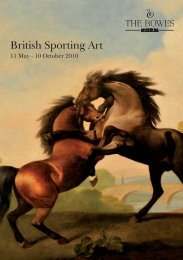Create successful ePaper yourself
Turn your PDF publications into a flip-book with our unique Google optimized e-Paper software.
Goya’s <strong>Prison</strong> – the Year of Despair explores the story<br />
behind these dark images and what compelled Goya<br />
to paint them.<br />
By 1792, Goya, approaching forty-six, had become<br />
bored with painting cartoons for the Royal Tapestry<br />
Factory. (Fig.10) Since 1775 he had painted more than<br />
sixty, full size, colour compositions. Some were huge.<br />
The money was good, but they were only for Royal<br />
consumption, and no wider audience saw them. In<br />
any case, the very nature of translating Goya’s painted<br />
images into large scale tapestry production forced<br />
his technique to limit its expressiveness. Goya’s<br />
career was at a crossroads. Although he had achieved<br />
acclaim and patronage as a painter of portraits, genre<br />
and religious scenes, it appears that he was not where<br />
he wanted to be. His destiny was determined after he<br />
was stricken by an illness that remains a mystery to<br />
this day. Whatever the cause of the illness, the year<br />
that followed marked a turning point in defining the<br />
career of one of Western art’s greatest masters.<br />
In October 1792, just before his illness struck, Goya<br />
had been one of a number of Academicians who<br />
addressed the Royal Academy with ideas for reforms<br />
in the teaching of art. Goya spoke passionately against<br />
the imposition of rules in painting and of a common<br />
curriculum to be forced upon all students. He criticised<br />
those who lauded the perfection of Greek statues as<br />
subject matter above the study of nature. Goya asked<br />
his audience:<br />
“What statue or cast of it might there be that<br />
is not copied from divine nature? As excellent<br />
as the artist may be who copied it, can he not<br />
but proclaim that when placed at its side, one<br />
is the work of God and the other of our own<br />
miserable hands?” 6<br />
Standing at the centre of the cultural elite of Madrid,<br />
Goya’s statement demonstrated his desire for all<br />
artists to enjoy an uninhibited freedom of expression<br />
and unbridled exploration of the imagination.<br />
9 Yard with Lunatics<br />
Francisco de Goya<br />
1793-4<br />
Oil on tinplate 43.5 x 32.4cm<br />
Dallas, Meadows Museum,<br />
Southern Methodist University<br />
5<br />
Goya’s <strong>Prison</strong> – the Year of Despair






